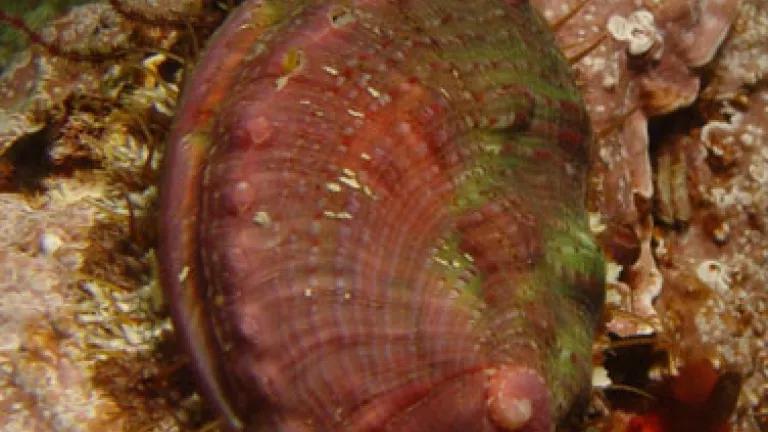
With its stunning mother-of-pearl shell and tasty muscular foot, the pinto abalone has long been considered a prize catch along the west coast of North America. Scientists are also increasingly worried that the pinto abalone is on the leading edge of effects from rising levels of greenhouse gases sent into our atmosphere and absorbed by our oceans, namely global warming and ocean acidification. Because of this “double whammy,” this fragile species now faces a perilous future, and even possible extinction, if we don’t act quickly. That’s why NRDC submitted a petition to the National Marine Fisheries Service today to list the pinto abalone as “endangered” under the Endangered Species Act.
(Photo by ADFG)
From Alaska down to Baja, Mexico, the pinto abalone used to populate shallow coastal areas in abundant numbers. The shell of this large sea snail can reach upwards of six inches in length, displaying reds and pinks on its exterior and a brilliant mother-of-pearl interior. Perched on rocky shores, the abalone uses a file-like tongue to scrape algae off the rocks for its sustenance.
While pinto abalone has been harvested for centuries, today this important species is getting harder and harder to find. Because it resides in shallow waters, the pinto abalone is both easily accessible to humans looking for a valuable catch, and readily exposed to the impacts of nearby development and other human activities, as well as natural disturbances like storms. This spells trouble for the species as a whole – monitoring in Washington, Alaska, and British Columbia shows that pinto abalone populations have declined by 80-90 percent (in some cases more) since the early 1990s. The southern subspecies of pinto abalone, found off Southern California’s coast, is estimated to have declined 99 percent.
While commercial and recreational fishing have historically led to population declines for the pinto abalone, today’s problem tells another story. In fact, the decline has continued even after commercial and recreational harvest had already been prohibited. Why, then, does the pinto abalone continue to struggle?
Illegal poaching is likely a problem. Studies also show that the pinto abalone is acutely sensitive to changes in salinity and temperature increases, such as we are starting to see as a result of global warming. The increasing acidity of marine waters − the result of our oceans absorbing more and more carbon dioxide − has also been shown to inhibit the abalone’s ability to form its shell.
The pinto abalone’s plight is so dire that scientists have already declared the species to be “functionally extinct” in some areas, such as in Washington State coastal waters. That means there’s no hope that the species will recover without immediate intervention. Without marine reserves to strengthen protections for spawning abalone, better enforcement of harvesting bans, and, in the long run, a reduction in greenhouse gas pollution, it is likely that the population will continue on its downward spiral.
The white and black abalone are already listed as “endangered” under the Endangered Species Act. Now it’s time to take action for the pinto abalone, putting the necessary safeguards in place to allow populations to spawn in a protected place, and increase abalone numbers off our west coast again. Quite frankly, it’s likely that failing to list the pinto abalone will result in scientists changing their assessment of the species from “functionally extinct” to just plain “extinct.”
The National Marine Fisheries Service now has 90 days to determine if our petition shows that an “endangered” listing for pinto abalone may be warranted. If it agrees, the fisheries agency will have another year to decide if it will, in fact, list the species under the ESA. As part of this process, the agency would solicit public comments, and it will be important that everyone who cares about the fate of the pinto abalone to weigh in.
So we will know more soon. In the meantime, I invite you to join me here to follow the new developments, and learn about opportunities for you to help. With your support, we look forward to moving forward to protect this beautiful sea snail – faster, hopefully, than at a snail’s pace.

